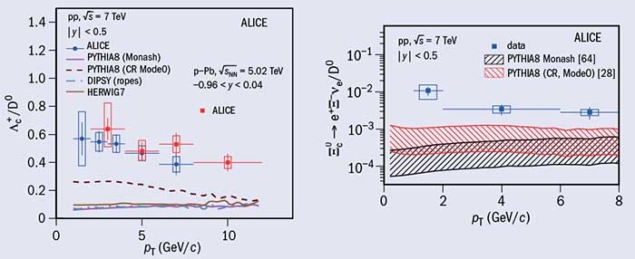
In two publications submitted to the Journal of High Energy Physics and Physics Letters B in December, the ALICE collaboration reports new production cross-section measurements of the charmed baryons Λ+c and Ξ0c in proton–proton collisions at an energy of 7 TeV and in proton–lead collisions at a collision energy of 5.02 TeV per nucleon–nucleon pair. The Λ+c were reconstructed in the hadronic decay modes Λ+c → pK− π+ and Λ+c → p K0S, and in the semileptonic channel Λ+c → e+ νe Λ (and charge conjugates). For the Ξ0c analysis, the semi-leptonic channel Ξ0c → e+ νe Ξ– was used.
The comparison of charm baryon and meson cross-sections provides information on c-quark hadronisation. Surprisingly, the measured values of the Λ+c/D0 baryon-to-meson ratio were significantly larger than those previously measured in other experiments in collisions involving electron beams at different centre-of-mass energies, rapidity and pT intervals.
The results (see figure) are compared with the expectations obtained from perturbative QCD calculations and Monte Carlo event generators. None of the models reproduce the data, indicating that the fragmentation of charm quarks is not well understood. A similar pattern is seen when comparing the Ξ0c/D0 baryon-to-meson ratio with predicted values (see figure, right), where the latter have a sizable uncertainty due to the unknown branching ratio of the decay.
These two results suggest that charmed baryon formation might not be universal, and that the baryon/meson ratio depends on the collision system. Hints of non-universality of the fragmentation functions are also seen when comparing beauty-baryon production measurements at the Tevatron and LHC with those at LEP. The ratios measured in pPb collisions are similar to the result in pp collisions.
The statistical precision of the Λ+c and Ξ0c measurements is expected to be improved with data collected during the LHC Run 2, and with data from Run 3 and Run 4 following a major upgrade of the ALICE apparatus. This set of measurements also provides a reference for future investigation of Λ+c and Ξ0c production in lead–lead collisions, where the formation and kinematic properties of charm baryons are expected to be affected by the presence of the quark–gluon plasma.
Further reading
ALICE Collaboration 2017 arXiv:1712.09581.
ALICE Collaboration 2017 arXiv:1712:04242.





